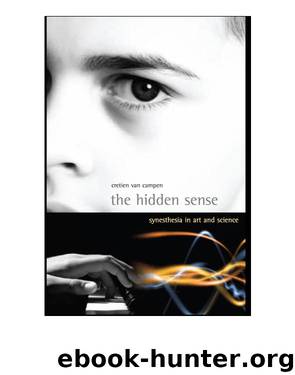The Hidden Sense by Cretien van Campen

Author:Cretien van Campen [SPi]
Language: eng
Format: epub
ISBN: 9780262220811
Publisher: The MIT Press
Arms on My Brains
If synesthetic metaphors do not flow from the floating pens of synesthetic writers, then how is synesthesia related to the use of synesthetic metaphors by poets? For ages, it has been the métier of many poets to find the right synesthetic combinations that best express sensory experiences. Poets like to use synesthetic metaphors because they provide a precise, concise, and pleasant way to express physical and sensory feelings, as the Dutch poet Hans Andreus (1926-1977) did in his book of poetry Liggen in de zon (Lying in the Sun), published in 1951 (my translation):
I hear the light the sunlight pizzicato
the warmth speaks against my face
Andreus was a member of the Dutch “Group of Fifty” (De Vijftigers) who revalued the sensory and the physical in poetry in the nineteen fifties. In their poetry they returned to sensual body impressions and studied them in detail, as if they were anatomists of human feelings. This resulted in a kind of poetry that had a disordering effect on the experiences of readers. They made experimental poetry in the true Latin meaning of the word experientia, which means “experiential” as well as “experimental.” According to a member of this group, Gerrit Kouwenaar, their poetry is characterized by the premise that “the body, the sensory experience and all that is connected by a social, biological, and psychological rubber band.” And they often encountered synesthesia on their path of experimental explorations of sensory experiences.
In his book Lichamelijkheid in de experimentele poëzie (Corporeality in Experimental Poetry), the linguist Hugo Brems even presents statistical proof for the statement that the Group of Fifty used more synesthetic metaphors than other poets in literary history. Brems provides many examples that contain correspondences between sensory impressions. In the case of Hans Andreus, the tactile sense is often the receiver of stimulation of other senses, as in the phrase “listening with the body,” when the skin feels auditory impressions. Guillaume van der Graft describes the same feeling when he says “We listen with our hands.” Jan G. Elburg tastes and feels thought in the line “Thinking with tongue and hands.” Remco Campert feels images on his skin when he writes “Before the clear day moves its healing hand over my skin.”
Hans Andreus is a champion in the sheer number of his uses of synesthetic metaphors among the Group of Fifty, according to the statistical analyses by Brems. Andreus’s first publication of a collection of poems in 1951 is entitled, typically rather than coincidentally, Muziek voor kijkdieren (Music for Looking Animals). It contains a variety of synesthetic metaphors that, remarkably, refer less to correspondences between sight and hearing, as the title suggests, and more to the tactile sense in the skin.
The rain of call as you want no rain
is heard by no ear is heard by the skin
Besides the tapping of raindrops, which is felt so penetratingly on the skin, Andreus most often feels the visual impressions of light on his skin, as in the lines on the rythmically speaking sunlight.
Download
This site does not store any files on its server. We only index and link to content provided by other sites. Please contact the content providers to delete copyright contents if any and email us, we'll remove relevant links or contents immediately.
| Administration & Medicine Economics | Allied Health Professions |
| Basic Sciences | Dentistry |
| History | Medical Informatics |
| Medicine | Nursing |
| Pharmacology | Psychology |
| Research | Veterinary Medicine |
The Art of Thinking Clearly by Rolf Dobelli(10149)
The 5 Love Languages: The Secret to Love That Lasts by Gary Chapman(9523)
Mindhunter: Inside the FBI's Elite Serial Crime Unit by John E. Douglas & Mark Olshaker(9112)
Becoming Supernatural by Dr. Joe Dispenza(8046)
The Road Less Traveled by M. Scott Peck(7480)
Nudge - Improving Decisions about Health, Wealth, and Happiness by Thaler Sunstein(7470)
Mastermind: How to Think Like Sherlock Holmes by Maria Konnikova(7174)
Enlightenment Now: The Case for Reason, Science, Humanism, and Progress by Steven Pinker(7091)
Win Bigly by Scott Adams(7039)
The Way of Zen by Alan W. Watts(6459)
Factfulness: Ten Reasons We're Wrong About the World – and Why Things Are Better Than You Think by Hans Rosling(4635)
The State of Affairs by Esther Perel(4594)
Gerald's Game by Stephen King(4521)
Man's Search for Meaning by Viktor Frankl(4363)
The Confidence Code by Katty Kay(4166)
Thinking in Bets by Annie Duke(4127)
Hidden Persuasion: 33 psychological influence techniques in advertising by Marc Andrews & Matthijs van Leeuwen & Rick van Baaren(3421)
The Healing Self by Deepak Chopra(3412)
The Worm at the Core by Sheldon Solomon(3401)
